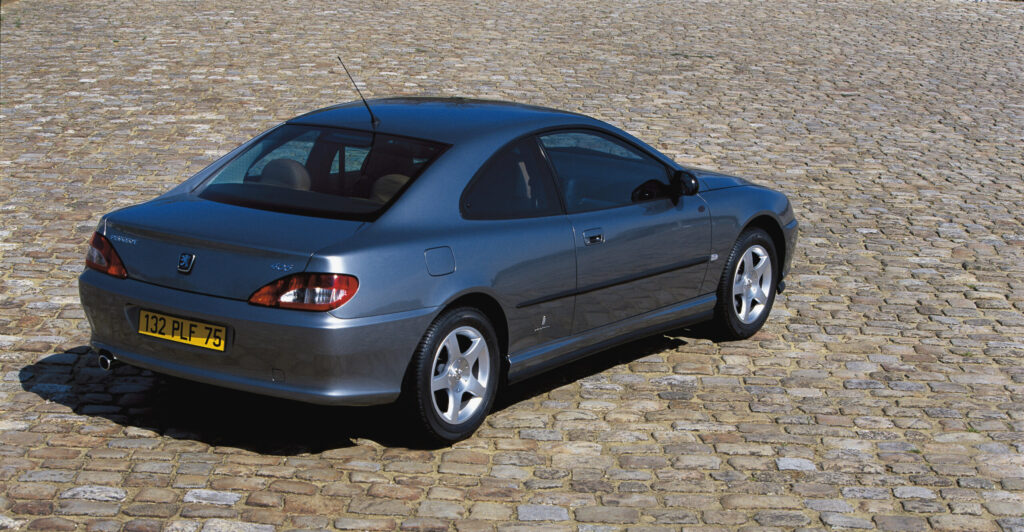If we’re living in the era of the SUV today, the 1990s were surely the glory years for the coupé. Pretty much every manufacturer was building swoopy two- doors, and Peugeot – no stranger to applying elegant bodies to its run-of-the-mill models – worked with Pininfarina to build one of the best looking the 406 Coupe.
It was often rumoured that the 406 Coupé was born out of a rejected baby Ferrari proposal, and there’s certainly more than a hint of 456 about it. In reality, though, it was a bespoke design – and one that was developed from start to finish by Pininfarina in Italy. Very little was carried over from the saloon, with no external panels shared, and only the floorpan was common with the four-door. Inside, the rather plain dashboard was retained, but the leather-clad Recaro seats raised the ambience several notches.
The Coupé was first unveiled to the public at the Paris motor show in 1996, officially going on sale later that year. From launch it was offered with a 2.0-litre, 135bhp four, and a 2.9-litre quad-cam 24v V6 producing 194bhp. Both were offered with five-speed manuals, as well as four-speed automatics.

Basic suspension architecture was shared with the saloon: MacPherson struts up front with a multi-link rear-end. Given Peugeot’s excellent reputation for ride and handling, that was no bad thing. The Coupé got a slightly lower set-up with a wider track, offering poise and comfort rather than a sharply dynamic balance. It was much more in GT territory than a sports car, most comfortable on fast, flowing A-roads and cruising the motorway in supreme style.
Although the entry-level car has the looks, the V6 was significantly more appealing. Stand-out features were big Brembo brakes on the front and the larger 16-inch wheels needed to contain them.
At about the same time as the saloon was facelifted in 1999, the original ‘D8’ Coupé became the D9. This brought in some improvements to the car’s electrical system, but also a new version of the 2.9-litre V6. With development outsourced to Porsche, it got revised cylinder heads, variable valve timing and a more sophisticated ignition system. Power was increased to 210bhp. The equipment level was also drastically improved, as was the selection of wheel designs. Two new engines were also introduced: a 160bhp 2.2 petrol and 136bhp 2.2 HDi diesel.

After the Coupé went off sale in the UK in 2003, it was given a slightly more comprehensive facelift for its final year of production. Moving to echo the rest of the range’s ‘grinning’ bumper grille, it looked slightly more modern, but lost much of the original’s subtlety. Pininfarina built the final car in 2005, with a surprising 107,633 being sold worldwide – most in France.
Like many cars of this era, the 406 Coupé has gone through a phase of huge attrition, not helped by low values. A strong enthusiast following has saved a few, but finding good cars is now difficult. Quite a few have been sacrificed in the name of building Ferrari 360 kit cars, too! There are still plenty of rough examples around, so it’s best to bide your time and wait for the right car. They are out there, and even the best are still criminally undervalued.
Common problems
• V6 engines are bulletproof, but most suffer from oil leaks. Ensure the timing belt is recent as it’s a big job.
• The manual gearbox is tough, too, but the four-speed ZF auto is less rugged. Check for smooth shifts and that all gears engage on a test drive.
• Corrosion can be a problem on the sills, B-pillars and inside the door jambs.
• Dead pixels on the sat-nav display are very common.
What to pay?
Numbers of rough cars have drastically thinned out, but you can still find sub-£1000 projects. Tread with caution, as some parts are expensive, and others near-impossible to find. Manual V6 cars are the most valuable, although even mint examples rarely sell for more than £5000. Decent cars start at £2500.
Lower-spec four-cylinder cars are generally cheaper, although something in very good condition might still fetch upwards of £3000. European readers might be surprised, as cars on the Continent are significantly more expensive.





